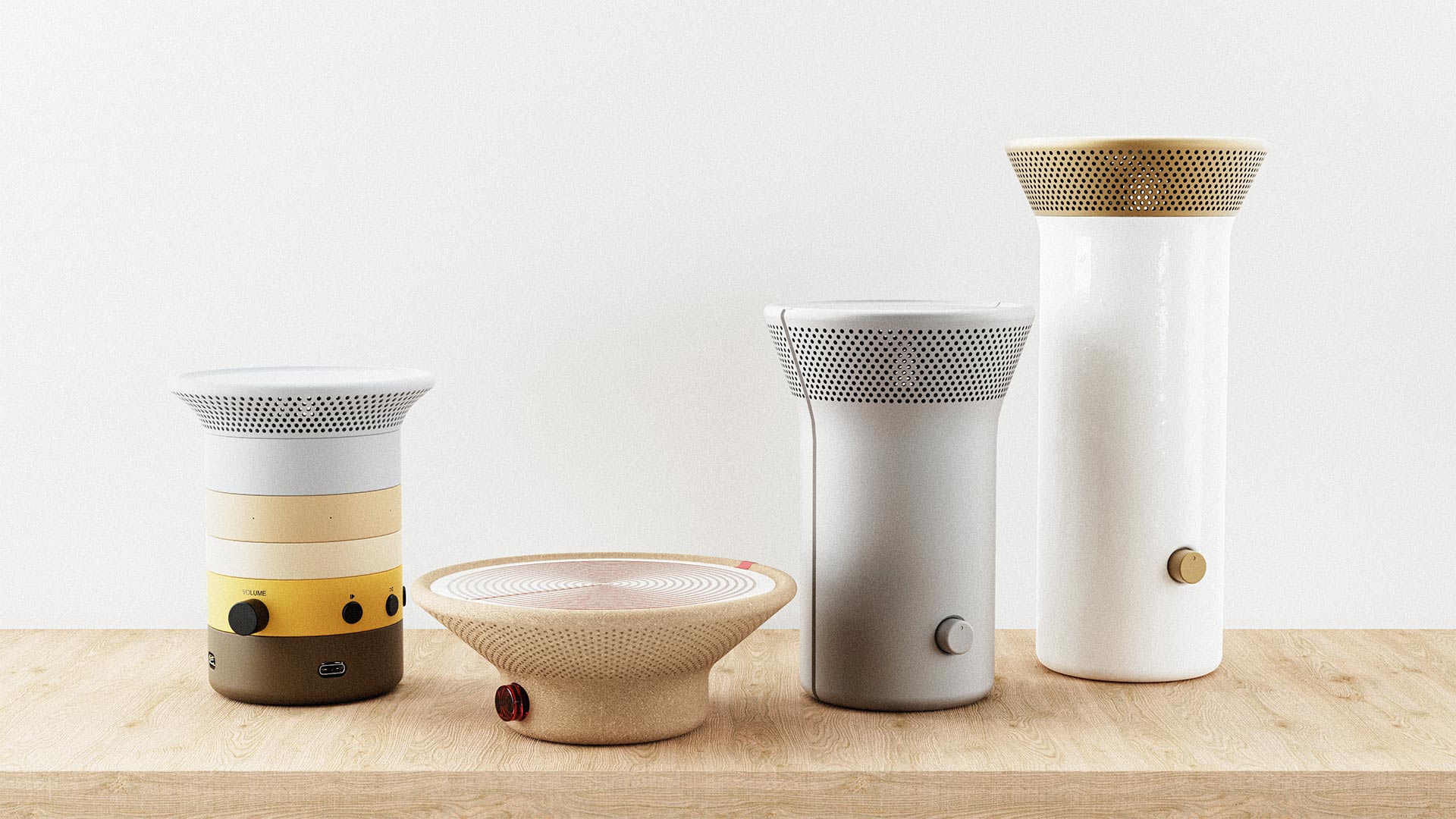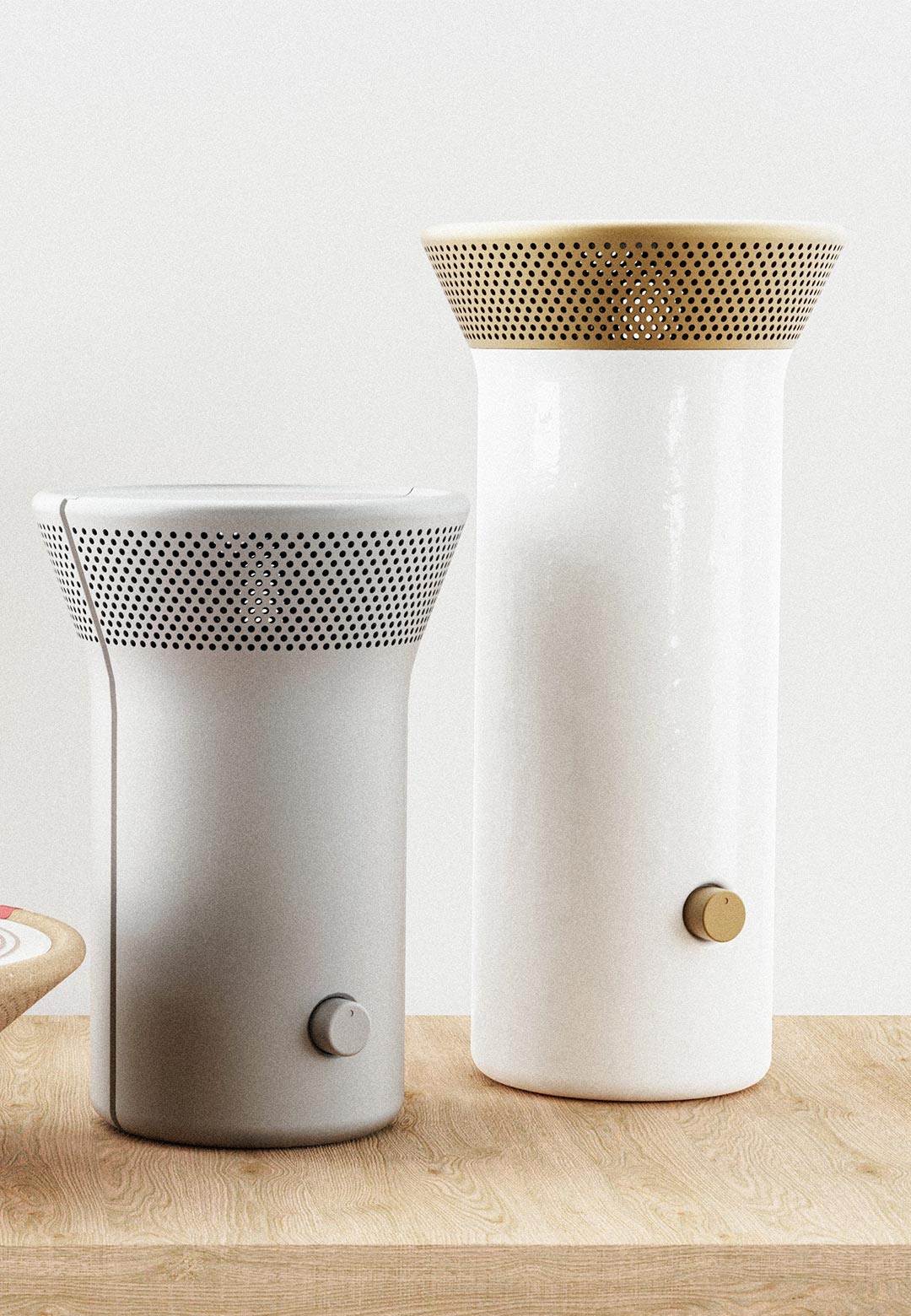In light of the burgeoning manufacturing of electronic devices, the creative community has had to grapple with the ecological impact of this incessant production, from material mining to the generation of e-waste.
Drawing inspiration from this thought, sustainability and innovation-led design agency FROLIC Studio has developed four 'smart' speakers, designed for repair and upgradeability, reduction and recycling, remanufacturing, and longevity. The Amsterdam-based studio refashions the perception of products by ideating bold and innovative solutions that challenge today’s linear thinking. The same speaker is a recycled product, redesigned four times to explore diversity in aesthetics, with functionalities arising from a single product when exposed to different sustainable strategies. “This collection of speakers is a unique take on smart speakers, designed to have a lighter impact on the planet. The four concepts challenge today's linear thinking by redesigning the same smart speaker and applying different sustainable design strategies each time. With smart speakers predicted to reach over 400 million sales by 2025, the collection is designed to shift towards a more circular model of product lifecycles, challenging unsustainable behaviours and exploring the diversity of design aesthetics and functionalities that sustainable design strategies can lead to,” shares Andrew Spitz, director of FROLIC Studio.
The fundamental concept and source of inspiration for the product designs ebbed from a desire to improve the world by developing environmentally friendly smart devices. “Most products are designed for a linear lifecycle, starting with non-renewable resources and ending as waste in landfills. Many of us continue to engage in unsustainable behaviours, such as buying new products when old ones break or not having the latest features,” Spitz rightly reminds us. The speaker collection highlights the possibilities of sustainable design principles based on extensive research and experimentation that guided its concept. “As a product design studio, it is part of our job to research, employ, and advocate for more sustainable products and footprints,” he continues.
The Netherlands-based studio believes that the impact of a new product's entire lifecycle must be minimised while designing it. Thereby, these speakers employ a holistic lifecycle strategy that mitigates this impact from the mining of materials and the ensuing electronic waste generated to the greatest extent possible. The emphasis is, therefore, on manufacturing, to ensure minimum depletion of raw materials and sustainable end-of-life solutions. “We dived deep into researching sustainable design principles and how they could be applied in practice: as a B Corp-certified studio, our commitment to sustainable practices is deeply rooted in our design process and informed by extensive research in sustainable product design interventions and applications,” Spitz elaborates.
For the design studio founded by Ruben van der Vleuten and Andrew Spitz in 2013, the collection marks knowledge to action through sketching, paper prototyping, 3D printing, and hands-on prototyping. Four categories were established, with specific material choices for each: repair and upgrade for recycled plastics; reducing and recycling for paper; remanufacturing for aluminium; and longevity for porcelain. “As we established that the materials set the four designs apart, we wanted their aesthetics to bind them back together. After lots of paper prototyping and 3D printing of geometries, we identified a form family for the four concepts. At this point, we further detailed the designs, beginning with learning more about audio design, passing through detailed CAD design and hi-fi 3D prints, experimenting with paper pulp and compression moulds, reaching out to a ceramics expert and again, lots of hands-on prototyping,” the product designers share.
FROLIC Studio's speakers incorporate six sustainable design facets—recyclable materials, reducing raw material depletion, accessible repair, easy disassembly, extending lifetimes, and ensuring proper disposal at the end of life their life cycles.
Speaker 1 | Repair and Upgradability
The design of 'Speaker 1' puts sustainability as a priority, by minimising waste through modularity. It also promotes long-lasting functionality and reduces environmental impact while supporting simple updates and maintenance. Its eco-friendliness is further enhanced by the use of widely accessible components and a compact cardboard casing with modular construction. Through a QR code, users can access a self-assessment repair tool that offers DIY instructions and repair alternatives, augmenting its 'smart' persona. The hardware schematic is made available to the public, and the design makes use of recyclable plastic as well.
Speaker 2 | Reducing and Recycling
“As designers, we often put out new things into the world when the most sustainable choice would be to produce less. The best we can do is to ensure that when designing for a new product, we minimise its whole lifecycle impact,” Spitz reiterates. The design of 'Speaker 2' focuses on sustainability with green manufacturing and end-of-life alternatives. It makes use of recyclable compressed-moulded paper fibres, which require less energy to produce. The absence of fixed fixtures makes disposal and disassembly simple. The speaker uses recyclable components such as glass buttons, a substrate made of biodegradable natural fibre, and a woofer's copper coil that has been regenerated for energy recovery. At the end of its life, a conspicuous red sticker on the back includes instructions for correct dismantling and recycling.
Speaker 3 | Remanufacturing
Aluminium is used as the key material to realise the design of 'Speaker 3,' owing to its long lifespan, and features of maximised durability and endless recycling. When repairs or modifications are no longer practical, materials can be remanufactured to reduce their impacts on the environment. Easy disassembly supports ethical recycling while a reachable take-back service encourages returns to the maker. The speaker's design incorporates an auto-locking, return shipping box and a take-back service with a deposit to encourage returns. Simple disassembly is made possible by a metal pin that is magnetised to keep it in place, allowing for easy tracking and remanufacturing of individual parts without the need for the manufacturer to perform a full refurbishment.
Speaker 4 | Longevity
'Speaker 4' puts emphasis on minimising impact during its lifespan through efficient utilisation of durable materials. The high-end and timeless design of the speaker is matched with equally high-end technology. The ceramic housing enables Kintsugi repair, enhancing its aesthetic and emotional worth, while promoting the acceptance of new beginnings, and the passing on of it to future generations. Ceramic is used due to its timelessness and heirloom potential and is accompanied by a luxurious brass top with a patina appearance completing the look. A universal RCA connector enables simple replacement or removal of the connecting module to adapt to future standards or serve as a traditional analogue speaker. Reliable and maintainable audio components are also employed.
The colour choices for each speaker are directly related to the materials that realise them, making them visually distinct yet cohesive. For 'Speaker 1,' using recycled plastic waste as a material gave them a variety of colour choices. Earth-toned pastel colours were chosen for its base (grey and brown), which along with a yellow highlight ensures 'Speaker 1' blended with the other three designs, while also standing out. The choice of compression-moulded paper fibres for 'Speaker 2' created a base colour that is naturally derived from paper pulp tones, with a bright red highlight provided by the copper coil. For 'Speaker 3,' the aluminium materiality produced a grey base, with an accent of blue to go with the one already present in the metal. The colours of the entire series flow together harmoniously, with the base colours offering a unifying theme and the accents adding distinctive personalities.
The speaker collection aptly follows the meaning of the studio's name, FROLIC. “It symbolises our approach and dedication to designing and prototyping sustainable products that are both functional and fun. By doing what we love the most, we want to inspire others also to embrace sustainable design practices and join us in creating a positive difference, one design at a time. By working together, we can make a significant impact and lead the way towards a better world,” Spitz says. FROLIC studio's design language and philosophy indulge heavily in sustainability and innovation, fuelled by a hands-on approach to design, physically manifested through this sustainable speakers collection. “Our mission is to guide businesses on their transition to bringing better products into the world, and along the way, we make these products irresistible, so all want to join in. The studio's name embodies this,” relays Spitz.
As the studio's design manifesto reveals, "In a world of problems, we are all about solutions. We believe in design as a force for good. And in our own small way, we want to leave the world a better place than we found it. So with that in mind, we aim to design and make products that have a positive environmental or societal impact, taking bright ideas from the starting blocks and using our years of experience to bring them into the world in a way that matters. In a way that works. In a way that makes a difference for us, and for those who come next."
Text by Ria Jha






 Sign in with email
Sign in with email










What do you think?